Managerial Accounting And Business Performance
VerifiedAdded on 2022/08/25
|17
|4004
|22
AI Summary
Contribute Materials
Your contribution can guide someone’s learning journey. Share your
documents today.
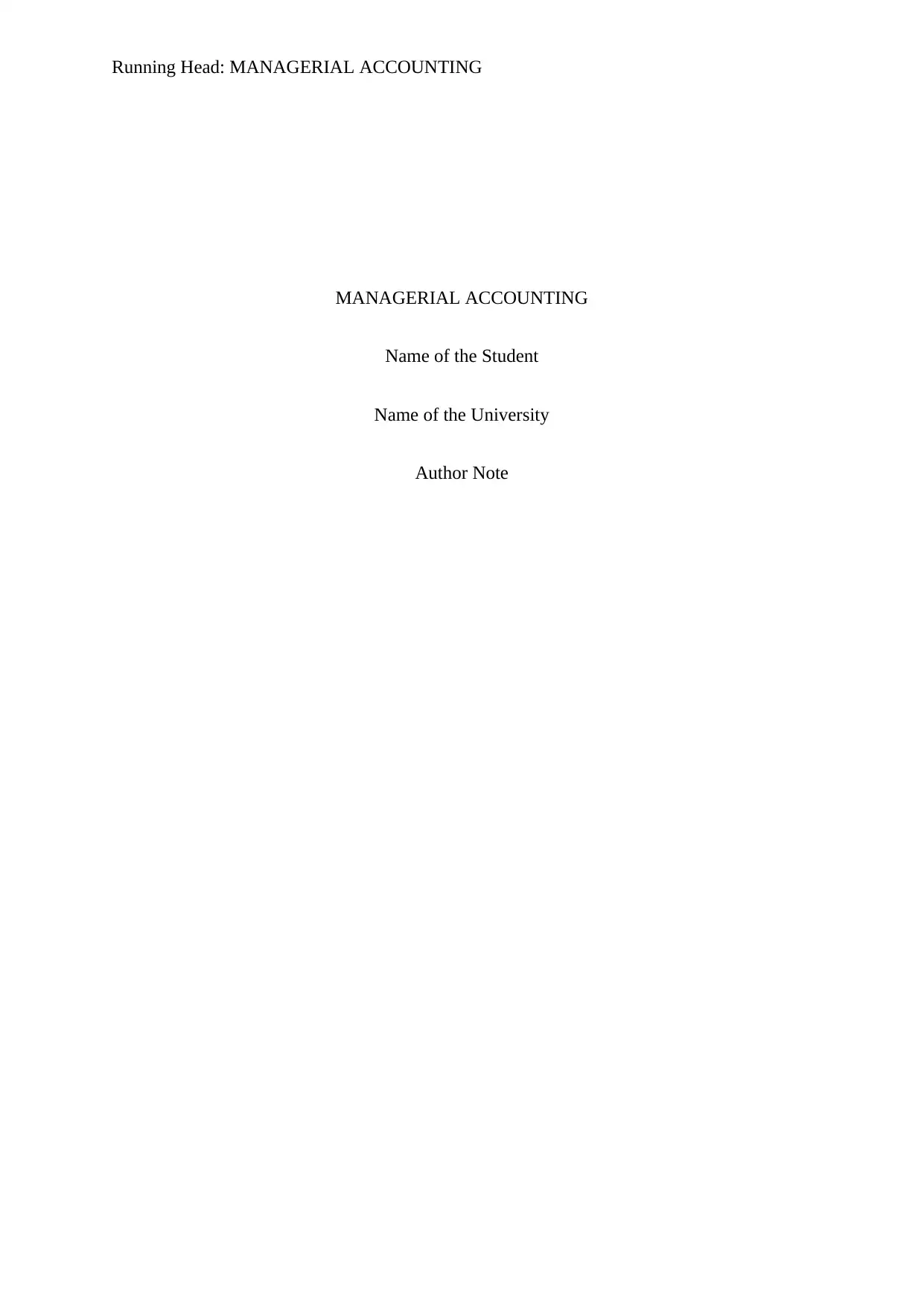
Running Head: MANAGERIAL ACCOUNTING
MANAGERIAL ACCOUNTING
Name of the Student
Name of the University
Author Note
MANAGERIAL ACCOUNTING
Name of the Student
Name of the University
Author Note
Secure Best Marks with AI Grader
Need help grading? Try our AI Grader for instant feedback on your assignments.
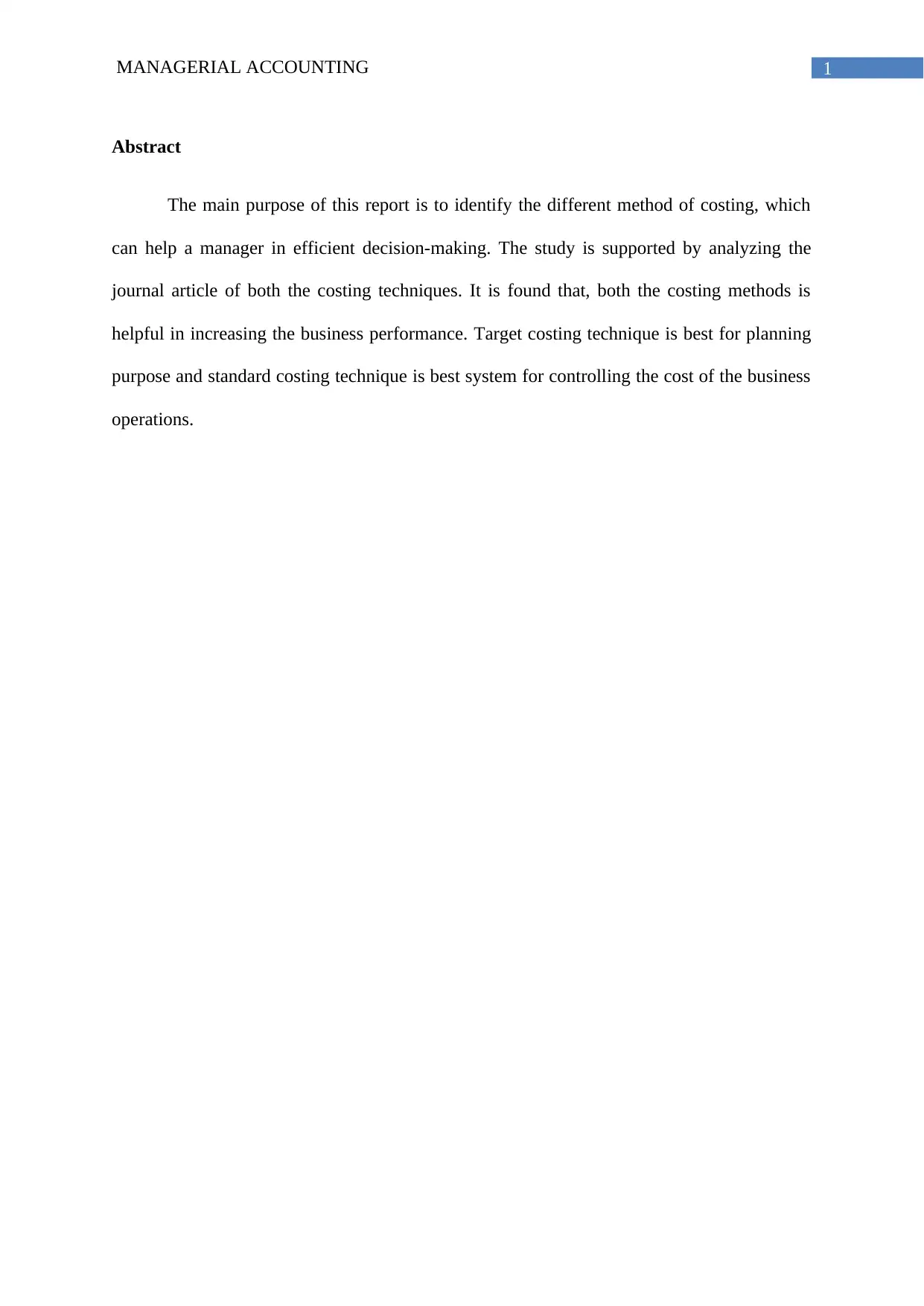
1MANAGERIAL ACCOUNTING
Abstract
The main purpose of this report is to identify the different method of costing, which
can help a manager in efficient decision-making. The study is supported by analyzing the
journal article of both the costing techniques. It is found that, both the costing methods is
helpful in increasing the business performance. Target costing technique is best for planning
purpose and standard costing technique is best system for controlling the cost of the business
operations.
Abstract
The main purpose of this report is to identify the different method of costing, which
can help a manager in efficient decision-making. The study is supported by analyzing the
journal article of both the costing techniques. It is found that, both the costing methods is
helpful in increasing the business performance. Target costing technique is best for planning
purpose and standard costing technique is best system for controlling the cost of the business
operations.
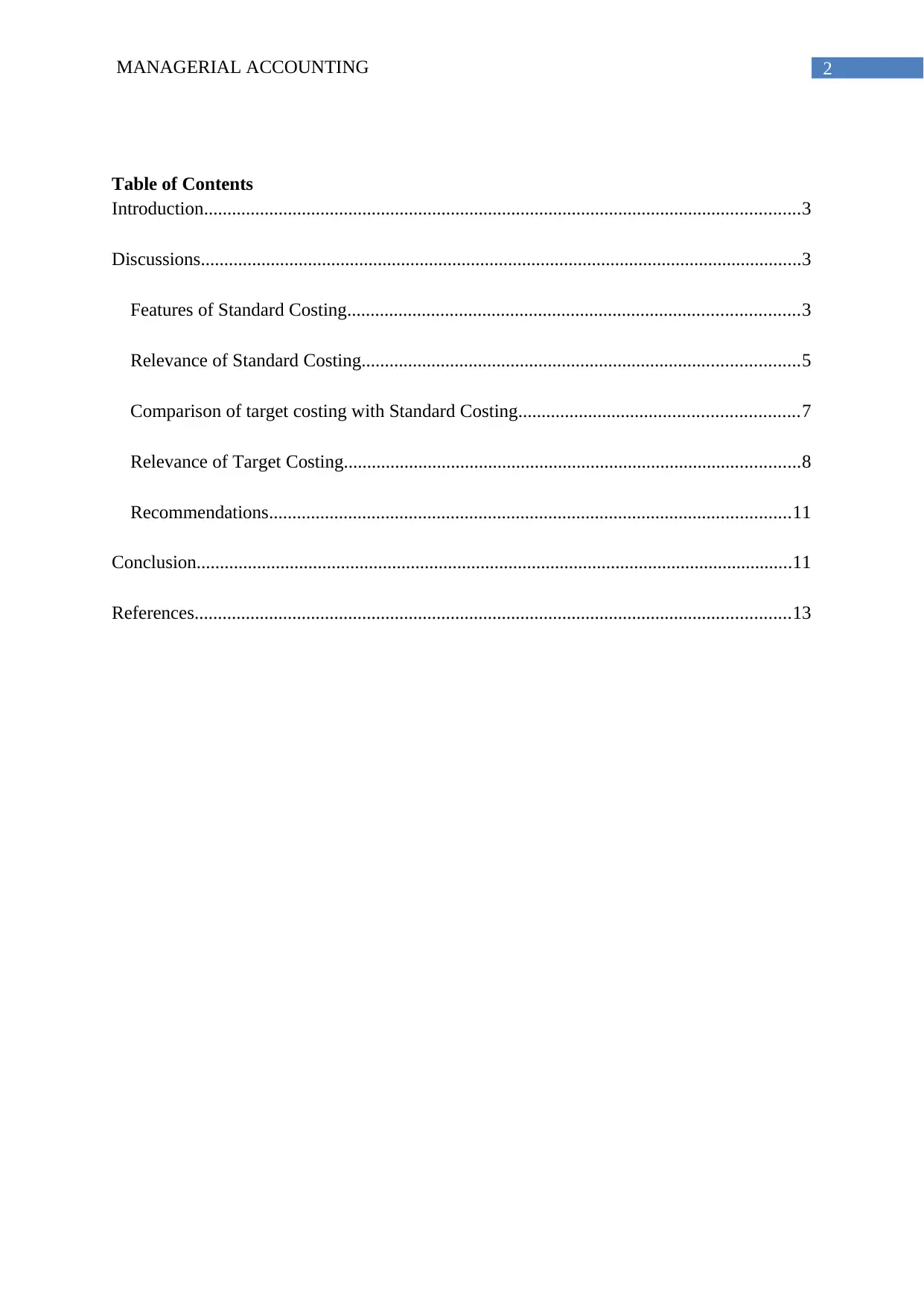
2MANAGERIAL ACCOUNTING
Table of Contents
Introduction................................................................................................................................3
Discussions.................................................................................................................................3
Features of Standard Costing.................................................................................................3
Relevance of Standard Costing..............................................................................................5
Comparison of target costing with Standard Costing............................................................7
Relevance of Target Costing..................................................................................................8
Recommendations................................................................................................................11
Conclusion................................................................................................................................11
References................................................................................................................................13
Table of Contents
Introduction................................................................................................................................3
Discussions.................................................................................................................................3
Features of Standard Costing.................................................................................................3
Relevance of Standard Costing..............................................................................................5
Comparison of target costing with Standard Costing............................................................7
Relevance of Target Costing..................................................................................................8
Recommendations................................................................................................................11
Conclusion................................................................................................................................11
References................................................................................................................................13
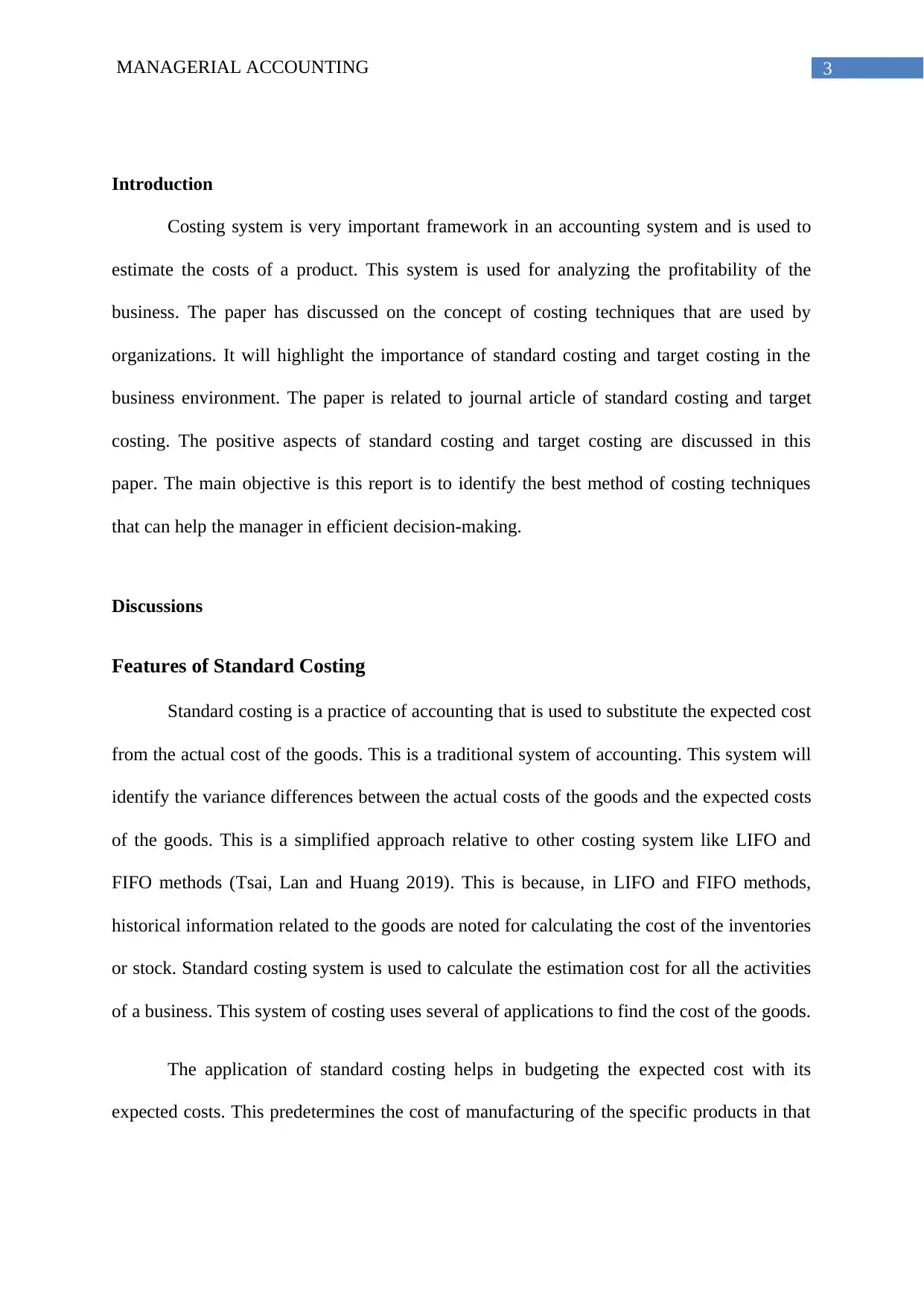
3MANAGERIAL ACCOUNTING
Introduction
Costing system is very important framework in an accounting system and is used to
estimate the costs of a product. This system is used for analyzing the profitability of the
business. The paper has discussed on the concept of costing techniques that are used by
organizations. It will highlight the importance of standard costing and target costing in the
business environment. The paper is related to journal article of standard costing and target
costing. The positive aspects of standard costing and target costing are discussed in this
paper. The main objective is this report is to identify the best method of costing techniques
that can help the manager in efficient decision-making.
Discussions
Features of Standard Costing
Standard costing is a practice of accounting that is used to substitute the expected cost
from the actual cost of the goods. This is a traditional system of accounting. This system will
identify the variance differences between the actual costs of the goods and the expected costs
of the goods. This is a simplified approach relative to other costing system like LIFO and
FIFO methods (Tsai, Lan and Huang 2019). This is because, in LIFO and FIFO methods,
historical information related to the goods are noted for calculating the cost of the inventories
or stock. Standard costing system is used to calculate the estimation cost for all the activities
of a business. This system of costing uses several of applications to find the cost of the goods.
The application of standard costing helps in budgeting the expected cost with its
expected costs. This predetermines the cost of manufacturing of the specific products in that
Introduction
Costing system is very important framework in an accounting system and is used to
estimate the costs of a product. This system is used for analyzing the profitability of the
business. The paper has discussed on the concept of costing techniques that are used by
organizations. It will highlight the importance of standard costing and target costing in the
business environment. The paper is related to journal article of standard costing and target
costing. The positive aspects of standard costing and target costing are discussed in this
paper. The main objective is this report is to identify the best method of costing techniques
that can help the manager in efficient decision-making.
Discussions
Features of Standard Costing
Standard costing is a practice of accounting that is used to substitute the expected cost
from the actual cost of the goods. This is a traditional system of accounting. This system will
identify the variance differences between the actual costs of the goods and the expected costs
of the goods. This is a simplified approach relative to other costing system like LIFO and
FIFO methods (Tsai, Lan and Huang 2019). This is because, in LIFO and FIFO methods,
historical information related to the goods are noted for calculating the cost of the inventories
or stock. Standard costing system is used to calculate the estimation cost for all the activities
of a business. This system of costing uses several of applications to find the cost of the goods.
The application of standard costing helps in budgeting the expected cost with its
expected costs. This predetermines the cost of manufacturing of the specific products in that
Secure Best Marks with AI Grader
Need help grading? Try our AI Grader for instant feedback on your assignments.
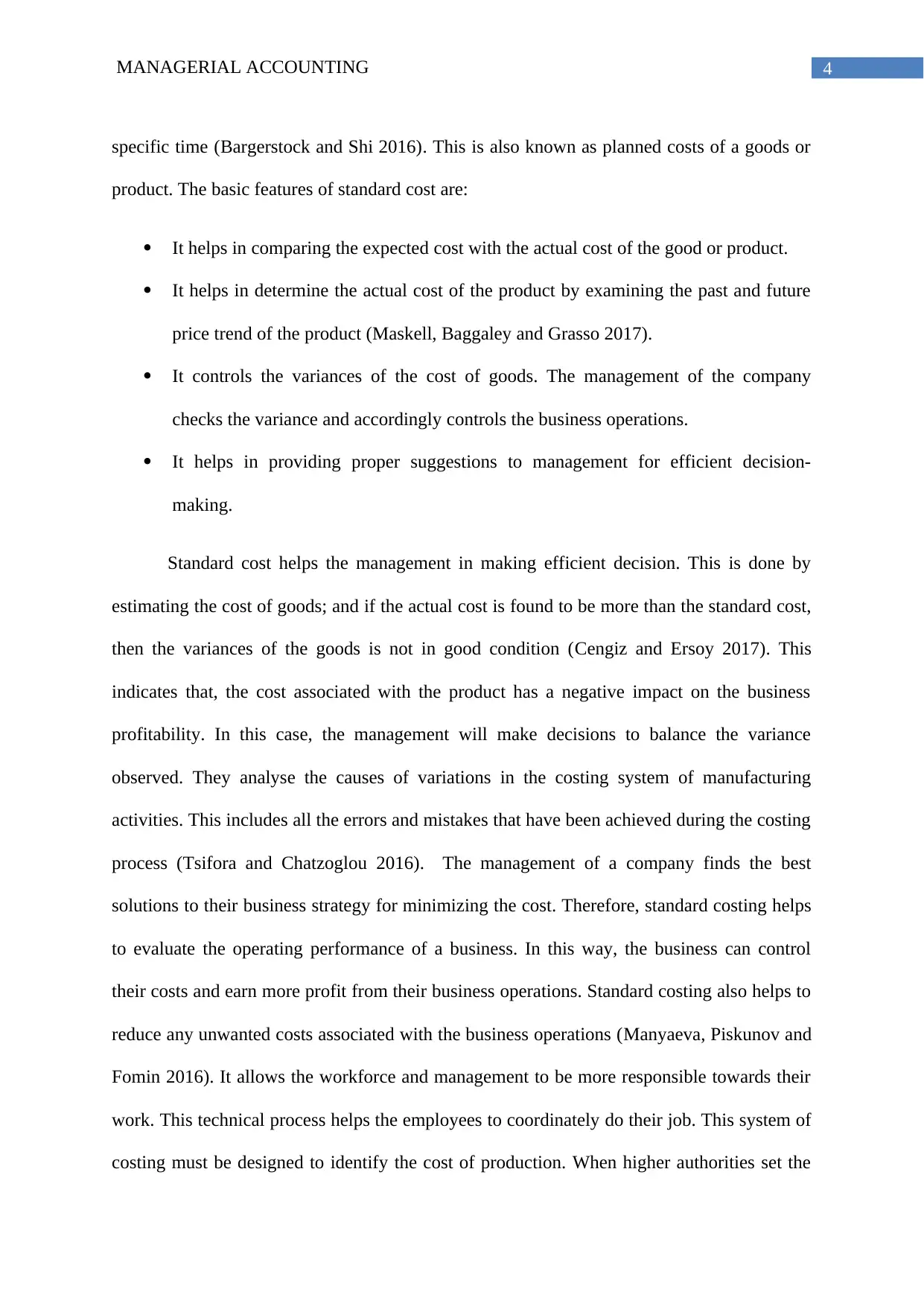
4MANAGERIAL ACCOUNTING
specific time (Bargerstock and Shi 2016). This is also known as planned costs of a goods or
product. The basic features of standard cost are:
It helps in comparing the expected cost with the actual cost of the good or product.
It helps in determine the actual cost of the product by examining the past and future
price trend of the product (Maskell, Baggaley and Grasso 2017).
It controls the variances of the cost of goods. The management of the company
checks the variance and accordingly controls the business operations.
It helps in providing proper suggestions to management for efficient decision-
making.
Standard cost helps the management in making efficient decision. This is done by
estimating the cost of goods; and if the actual cost is found to be more than the standard cost,
then the variances of the goods is not in good condition (Cengiz and Ersoy 2017). This
indicates that, the cost associated with the product has a negative impact on the business
profitability. In this case, the management will make decisions to balance the variance
observed. They analyse the causes of variations in the costing system of manufacturing
activities. This includes all the errors and mistakes that have been achieved during the costing
process (Tsifora and Chatzoglou 2016). The management of a company finds the best
solutions to their business strategy for minimizing the cost. Therefore, standard costing helps
to evaluate the operating performance of a business. In this way, the business can control
their costs and earn more profit from their business operations. Standard costing also helps to
reduce any unwanted costs associated with the business operations (Manyaeva, Piskunov and
Fomin 2016). It allows the workforce and management to be more responsible towards their
work. This technical process helps the employees to coordinately do their job. This system of
costing must be designed to identify the cost of production. When higher authorities set the
specific time (Bargerstock and Shi 2016). This is also known as planned costs of a goods or
product. The basic features of standard cost are:
It helps in comparing the expected cost with the actual cost of the good or product.
It helps in determine the actual cost of the product by examining the past and future
price trend of the product (Maskell, Baggaley and Grasso 2017).
It controls the variances of the cost of goods. The management of the company
checks the variance and accordingly controls the business operations.
It helps in providing proper suggestions to management for efficient decision-
making.
Standard cost helps the management in making efficient decision. This is done by
estimating the cost of goods; and if the actual cost is found to be more than the standard cost,
then the variances of the goods is not in good condition (Cengiz and Ersoy 2017). This
indicates that, the cost associated with the product has a negative impact on the business
profitability. In this case, the management will make decisions to balance the variance
observed. They analyse the causes of variations in the costing system of manufacturing
activities. This includes all the errors and mistakes that have been achieved during the costing
process (Tsifora and Chatzoglou 2016). The management of a company finds the best
solutions to their business strategy for minimizing the cost. Therefore, standard costing helps
to evaluate the operating performance of a business. In this way, the business can control
their costs and earn more profit from their business operations. Standard costing also helps to
reduce any unwanted costs associated with the business operations (Manyaeva, Piskunov and
Fomin 2016). It allows the workforce and management to be more responsible towards their
work. This technical process helps the employees to coordinately do their job. This system of
costing must be designed to identify the cost of production. When higher authorities set the
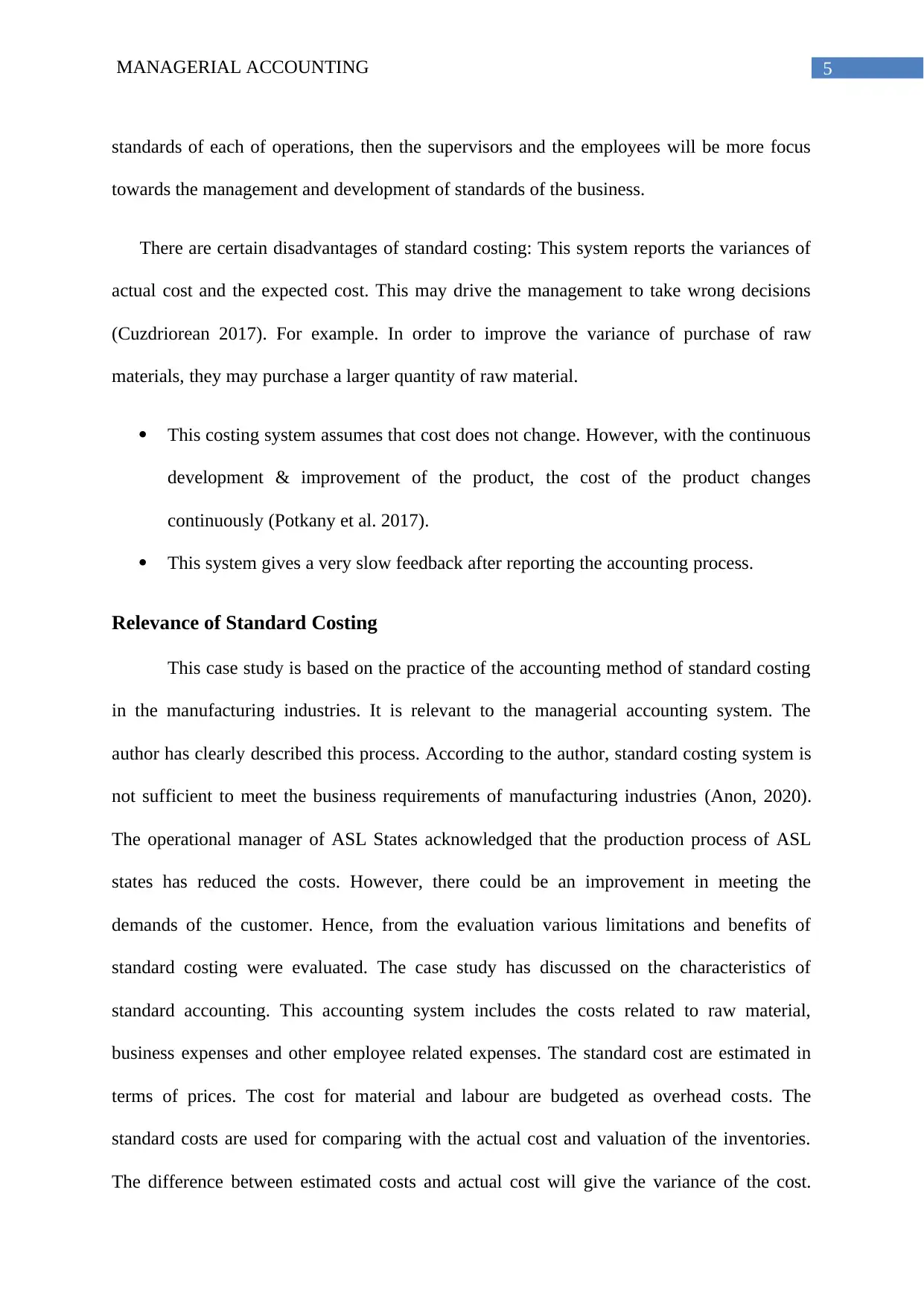
5MANAGERIAL ACCOUNTING
standards of each of operations, then the supervisors and the employees will be more focus
towards the management and development of standards of the business.
There are certain disadvantages of standard costing: This system reports the variances of
actual cost and the expected cost. This may drive the management to take wrong decisions
(Cuzdriorean 2017). For example. In order to improve the variance of purchase of raw
materials, they may purchase a larger quantity of raw material.
This costing system assumes that cost does not change. However, with the continuous
development & improvement of the product, the cost of the product changes
continuously (Potkany et al. 2017).
This system gives a very slow feedback after reporting the accounting process.
Relevance of Standard Costing
This case study is based on the practice of the accounting method of standard costing
in the manufacturing industries. It is relevant to the managerial accounting system. The
author has clearly described this process. According to the author, standard costing system is
not sufficient to meet the business requirements of manufacturing industries (Anon, 2020).
The operational manager of ASL States acknowledged that the production process of ASL
states has reduced the costs. However, there could be an improvement in meeting the
demands of the customer. Hence, from the evaluation various limitations and benefits of
standard costing were evaluated. The case study has discussed on the characteristics of
standard accounting. This accounting system includes the costs related to raw material,
business expenses and other employee related expenses. The standard cost are estimated in
terms of prices. The cost for material and labour are budgeted as overhead costs. The
standard costs are used for comparing with the actual cost and valuation of the inventories.
The difference between estimated costs and actual cost will give the variance of the cost.
standards of each of operations, then the supervisors and the employees will be more focus
towards the management and development of standards of the business.
There are certain disadvantages of standard costing: This system reports the variances of
actual cost and the expected cost. This may drive the management to take wrong decisions
(Cuzdriorean 2017). For example. In order to improve the variance of purchase of raw
materials, they may purchase a larger quantity of raw material.
This costing system assumes that cost does not change. However, with the continuous
development & improvement of the product, the cost of the product changes
continuously (Potkany et al. 2017).
This system gives a very slow feedback after reporting the accounting process.
Relevance of Standard Costing
This case study is based on the practice of the accounting method of standard costing
in the manufacturing industries. It is relevant to the managerial accounting system. The
author has clearly described this process. According to the author, standard costing system is
not sufficient to meet the business requirements of manufacturing industries (Anon, 2020).
The operational manager of ASL States acknowledged that the production process of ASL
states has reduced the costs. However, there could be an improvement in meeting the
demands of the customer. Hence, from the evaluation various limitations and benefits of
standard costing were evaluated. The case study has discussed on the characteristics of
standard accounting. This accounting system includes the costs related to raw material,
business expenses and other employee related expenses. The standard cost are estimated in
terms of prices. The cost for material and labour are budgeted as overhead costs. The
standard costs are used for comparing with the actual cost and valuation of the inventories.
The difference between estimated costs and actual cost will give the variance of the cost.

6MANAGERIAL ACCOUNTING
Variance can be used to take control measures on costs. Standard costing system has various
benefits in the production process. It helps in enhancing the budgeting process. The suppliers
can easily be changed & better raw materials can be generated for enhancing the production
process. Standard costing system helps the management to control their operations cost and
get involve towards their job. The staffs and the management to get a positive result on the
variance can manipulate standard costing system. They can estimate a higher cost for their
own benefit. ASL States should focus on improving the financial and operational
performance of the business. This can be done by adopting a better cost control system in the
business. Modern accounting system of Total Quality Management will focus on the financial
improvement of the business. This system measures the efficiency by analyzing the
complaints of the customers and returns on the business. But, ASL depends on standard
costing system because, the modern system cannot cut the costs related to the business
operations. The company is focusing on the cost leadership strategy to meet the customers
needs. This helps the company to charge a premium on the price. Therefore, the cost
leadership strategy will help the company to control their cost of business operation. In
differentiation strategy, the cost leadership cannot be executed. The operational manager of
ASL States that, standard costing system will help in controlling the costs of the production
process and increase the efficiency of manufacturing activities. But, the standard costing
system should be advanced and retained to increase the efficiency of cost control in the
business. Then , the modern costing system of activity based costing can be used to create
value for the customers.
The above features of standard costing doesnot satisfies to the real standard costing
system of accounting system. This is because the main purpose of standard costing system is
to determine the expected cost with the actual cost of the goods and services. In the today’s
Variance can be used to take control measures on costs. Standard costing system has various
benefits in the production process. It helps in enhancing the budgeting process. The suppliers
can easily be changed & better raw materials can be generated for enhancing the production
process. Standard costing system helps the management to control their operations cost and
get involve towards their job. The staffs and the management to get a positive result on the
variance can manipulate standard costing system. They can estimate a higher cost for their
own benefit. ASL States should focus on improving the financial and operational
performance of the business. This can be done by adopting a better cost control system in the
business. Modern accounting system of Total Quality Management will focus on the financial
improvement of the business. This system measures the efficiency by analyzing the
complaints of the customers and returns on the business. But, ASL depends on standard
costing system because, the modern system cannot cut the costs related to the business
operations. The company is focusing on the cost leadership strategy to meet the customers
needs. This helps the company to charge a premium on the price. Therefore, the cost
leadership strategy will help the company to control their cost of business operation. In
differentiation strategy, the cost leadership cannot be executed. The operational manager of
ASL States that, standard costing system will help in controlling the costs of the production
process and increase the efficiency of manufacturing activities. But, the standard costing
system should be advanced and retained to increase the efficiency of cost control in the
business. Then , the modern costing system of activity based costing can be used to create
value for the customers.
The above features of standard costing doesnot satisfies to the real standard costing
system of accounting system. This is because the main purpose of standard costing system is
to determine the expected cost with the actual cost of the goods and services. In the today’s
Paraphrase This Document
Need a fresh take? Get an instant paraphrase of this document with our AI Paraphraser

7MANAGERIAL ACCOUNTING
business state, this system cannot be accurate to determine the expected cost, because the
expected cost may vary as we compare it to the real cost associated with the goods.
Moreover, costing system is used to maintain the cost and enhance the business outcome.
Comparison of target costing with Standard Costing
Target costing is used to determine the cost of product life cycle. This is used to set a
target cost of a product that a firm can use. It is the maximum amount of cost that is
associated with the product. This cost maintains the quality and functionality of the product
(Helms et al. 2005). This cost is used during the product-designing phase of the product life
cycle. This is a type of cost planning process, which focuses on reducing the cost associated
during the product-designing phase. Target costing includes three faces; the first phase
focuses mainly on the long-term profit that can be generated from the product. This phase
identifies market conditions of the product (Hassan and Mohamed 2018). The second phase
involves utilization of various strategies for cost reduction in the product designing process.
The third phase includes a component-level cost. This tool is also a managerial tool in
estimating the price associated with project designing process (Steyn 2017). The management
can plan its project using this costing tool. This tool also helps to make a consistent profit
especially in the health care and construction sectors (Rasit and Ismail 2017). The
management can evaluate the target cost of the product by analyzing the demand and supply
of that product in the market place. There are certain factors that affects the target cost of a
product. These factors includes; the intensity of competition in the market place, the product
level strategy in the business and the supplier’s strategy related to the product (Clermont,
Ahn and Schwetschke 2018). These factors change over time in a marketplace and can
change the company strategy of doing product operations.
Comparison:
business state, this system cannot be accurate to determine the expected cost, because the
expected cost may vary as we compare it to the real cost associated with the goods.
Moreover, costing system is used to maintain the cost and enhance the business outcome.
Comparison of target costing with Standard Costing
Target costing is used to determine the cost of product life cycle. This is used to set a
target cost of a product that a firm can use. It is the maximum amount of cost that is
associated with the product. This cost maintains the quality and functionality of the product
(Helms et al. 2005). This cost is used during the product-designing phase of the product life
cycle. This is a type of cost planning process, which focuses on reducing the cost associated
during the product-designing phase. Target costing includes three faces; the first phase
focuses mainly on the long-term profit that can be generated from the product. This phase
identifies market conditions of the product (Hassan and Mohamed 2018). The second phase
involves utilization of various strategies for cost reduction in the product designing process.
The third phase includes a component-level cost. This tool is also a managerial tool in
estimating the price associated with project designing process (Steyn 2017). The management
can plan its project using this costing tool. This tool also helps to make a consistent profit
especially in the health care and construction sectors (Rasit and Ismail 2017). The
management can evaluate the target cost of the product by analyzing the demand and supply
of that product in the market place. There are certain factors that affects the target cost of a
product. These factors includes; the intensity of competition in the market place, the product
level strategy in the business and the supplier’s strategy related to the product (Clermont,
Ahn and Schwetschke 2018). These factors change over time in a marketplace and can
change the company strategy of doing product operations.
Comparison:
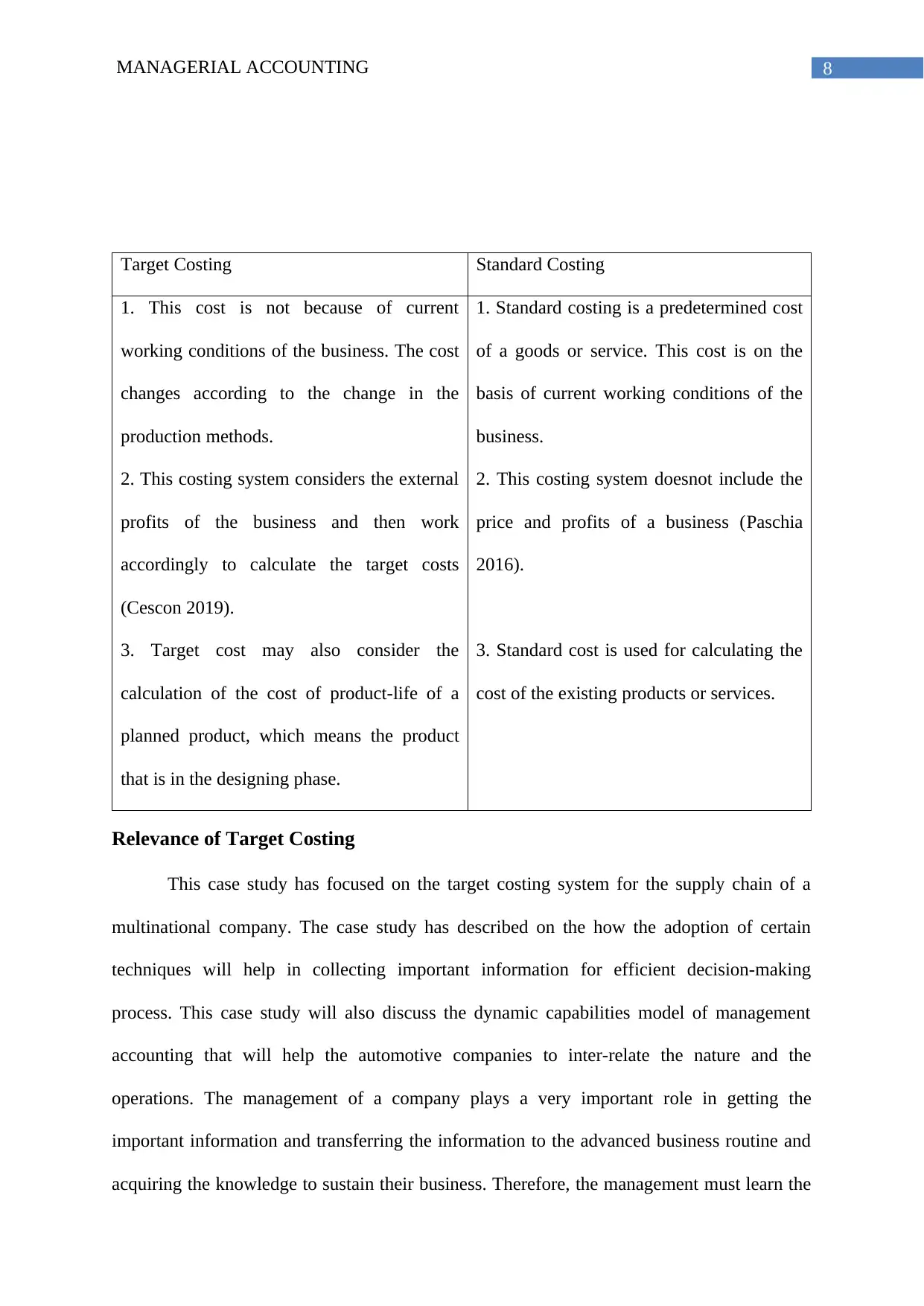
8MANAGERIAL ACCOUNTING
Target Costing Standard Costing
1. This cost is not because of current
working conditions of the business. The cost
changes according to the change in the
production methods.
2. This costing system considers the external
profits of the business and then work
accordingly to calculate the target costs
(Cescon 2019).
3. Target cost may also consider the
calculation of the cost of product-life of a
planned product, which means the product
that is in the designing phase.
1. Standard costing is a predetermined cost
of a goods or service. This cost is on the
basis of current working conditions of the
business.
2. This costing system doesnot include the
price and profits of a business (Paschia
2016).
3. Standard cost is used for calculating the
cost of the existing products or services.
Relevance of Target Costing
This case study has focused on the target costing system for the supply chain of a
multinational company. The case study has described on the how the adoption of certain
techniques will help in collecting important information for efficient decision-making
process. This case study will also discuss the dynamic capabilities model of management
accounting that will help the automotive companies to inter-relate the nature and the
operations. The management of a company plays a very important role in getting the
important information and transferring the information to the advanced business routine and
acquiring the knowledge to sustain their business. Therefore, the management must learn the
Target Costing Standard Costing
1. This cost is not because of current
working conditions of the business. The cost
changes according to the change in the
production methods.
2. This costing system considers the external
profits of the business and then work
accordingly to calculate the target costs
(Cescon 2019).
3. Target cost may also consider the
calculation of the cost of product-life of a
planned product, which means the product
that is in the designing phase.
1. Standard costing is a predetermined cost
of a goods or service. This cost is on the
basis of current working conditions of the
business.
2. This costing system doesnot include the
price and profits of a business (Paschia
2016).
3. Standard cost is used for calculating the
cost of the existing products or services.
Relevance of Target Costing
This case study has focused on the target costing system for the supply chain of a
multinational company. The case study has described on the how the adoption of certain
techniques will help in collecting important information for efficient decision-making
process. This case study will also discuss the dynamic capabilities model of management
accounting that will help the automotive companies to inter-relate the nature and the
operations. The management of a company plays a very important role in getting the
important information and transferring the information to the advanced business routine and
acquiring the knowledge to sustain their business. Therefore, the management must learn the

9MANAGERIAL ACCOUNTING
dynamic capabilities to integrate with the business strategy. The managers can include the
dynamic capabilities by adopting a proper managerial accounting system. Dynamic
capabilities is applied with the target costing techniques in the organisation process for
efficient decision-making process. The case study adds an external pressure to the
management on proper implementation of target costing in today’s automotive world. Failing
in proper understand of the various issues in the company. The resource and dynamic
capabilities is the most competitive advantages of this firm. An organisational can be tangible
and intangible asset that can control the business operations (Knight and Collier, 2009). The
administrative department make this decisions on providing wider opportunities to the
management for successful decision making process. It support the management in providing
the resources. An organisation have the capabilities to properly perform their task in order to
get their desired result. But, the dynamic capabilities change. This includes change in
operational and language capabilities in the manufacturing activities. But, these dynamic
capabilities are embedded in the organisational culture and structure for making strategic
planning and processing. Dynamic capabilities create a value in providing the competitive
advantages. Hence, the value lies in resources and integrating the business process in the
operations. Dynamic capabilities have different product life cycles that help the firm to
emerge in the developing environment. Hence, it provides opportunities and threats to create
a competitive advantage. Organistaions should be capable of changing the dynamic
capabilities. In this, dynamic managerial capabilities is also equally important. Target costing
was developed in Toyota Motor Corporation. They created a target price for the vehicle and
analysed the targeted profit for the suppliers and assemblers. It includes each stage of
production process. It includes product-costing, requirements for the customers and
customer’s willingness to pay. This costing system was regarded as the most efficient
planning technique for the accountants.
dynamic capabilities to integrate with the business strategy. The managers can include the
dynamic capabilities by adopting a proper managerial accounting system. Dynamic
capabilities is applied with the target costing techniques in the organisation process for
efficient decision-making process. The case study adds an external pressure to the
management on proper implementation of target costing in today’s automotive world. Failing
in proper understand of the various issues in the company. The resource and dynamic
capabilities is the most competitive advantages of this firm. An organisational can be tangible
and intangible asset that can control the business operations (Knight and Collier, 2009). The
administrative department make this decisions on providing wider opportunities to the
management for successful decision making process. It support the management in providing
the resources. An organisation have the capabilities to properly perform their task in order to
get their desired result. But, the dynamic capabilities change. This includes change in
operational and language capabilities in the manufacturing activities. But, these dynamic
capabilities are embedded in the organisational culture and structure for making strategic
planning and processing. Dynamic capabilities create a value in providing the competitive
advantages. Hence, the value lies in resources and integrating the business process in the
operations. Dynamic capabilities have different product life cycles that help the firm to
emerge in the developing environment. Hence, it provides opportunities and threats to create
a competitive advantage. Organistaions should be capable of changing the dynamic
capabilities. In this, dynamic managerial capabilities is also equally important. Target costing
was developed in Toyota Motor Corporation. They created a target price for the vehicle and
analysed the targeted profit for the suppliers and assemblers. It includes each stage of
production process. It includes product-costing, requirements for the customers and
customer’s willingness to pay. This costing system was regarded as the most efficient
planning technique for the accountants.
Secure Best Marks with AI Grader
Need help grading? Try our AI Grader for instant feedback on your assignments.
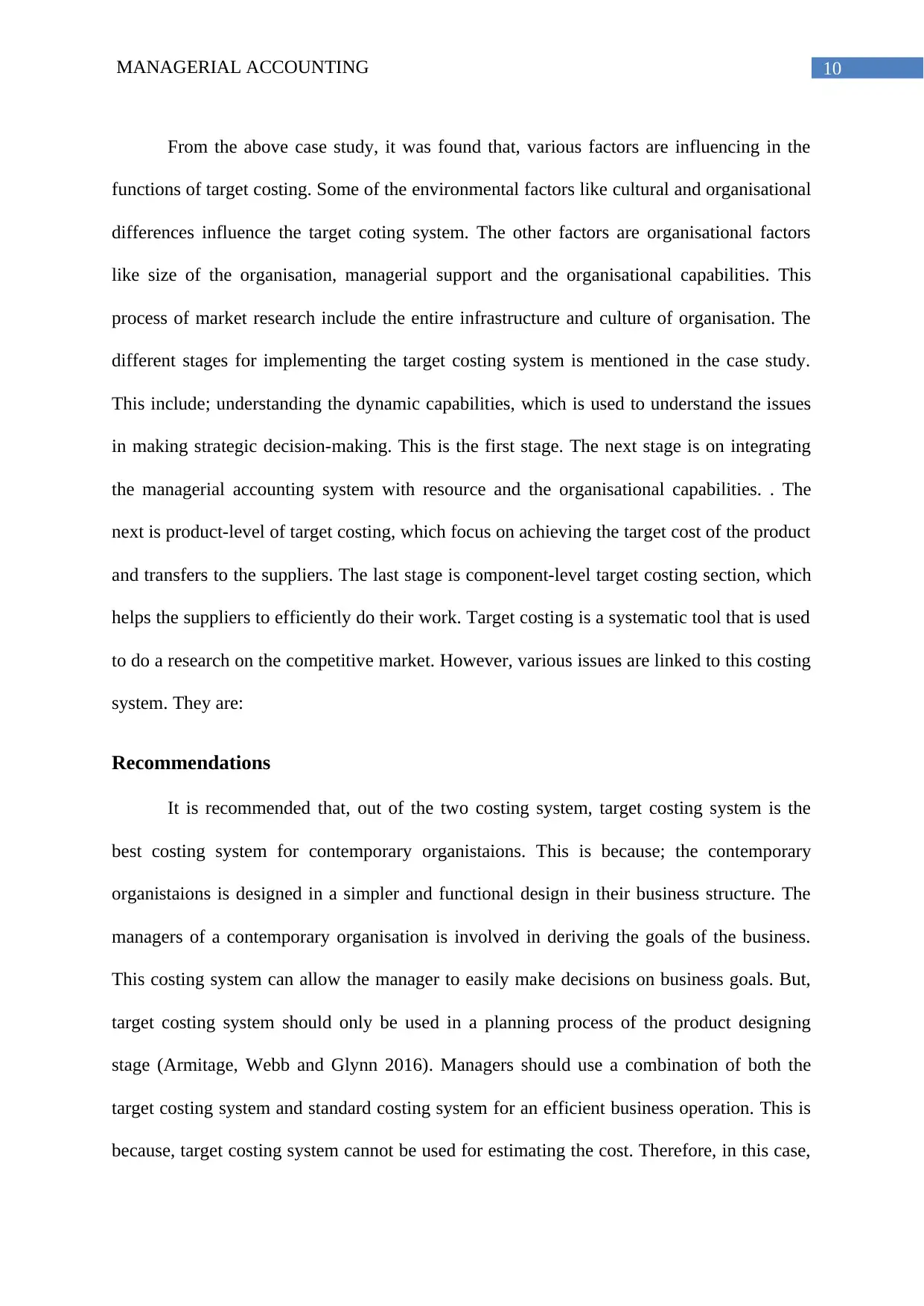
10MANAGERIAL ACCOUNTING
From the above case study, it was found that, various factors are influencing in the
functions of target costing. Some of the environmental factors like cultural and organisational
differences influence the target coting system. The other factors are organisational factors
like size of the organisation, managerial support and the organisational capabilities. This
process of market research include the entire infrastructure and culture of organisation. The
different stages for implementing the target costing system is mentioned in the case study.
This include; understanding the dynamic capabilities, which is used to understand the issues
in making strategic decision-making. This is the first stage. The next stage is on integrating
the managerial accounting system with resource and the organisational capabilities. . The
next is product-level of target costing, which focus on achieving the target cost of the product
and transfers to the suppliers. The last stage is component-level target costing section, which
helps the suppliers to efficiently do their work. Target costing is a systematic tool that is used
to do a research on the competitive market. However, various issues are linked to this costing
system. They are:
Recommendations
It is recommended that, out of the two costing system, target costing system is the
best costing system for contemporary organistaions. This is because; the contemporary
organistaions is designed in a simpler and functional design in their business structure. The
managers of a contemporary organisation is involved in deriving the goals of the business.
This costing system can allow the manager to easily make decisions on business goals. But,
target costing system should only be used in a planning process of the product designing
stage (Armitage, Webb and Glynn 2016). Managers should use a combination of both the
target costing system and standard costing system for an efficient business operation. This is
because, target costing system cannot be used for estimating the cost. Therefore, in this case,
From the above case study, it was found that, various factors are influencing in the
functions of target costing. Some of the environmental factors like cultural and organisational
differences influence the target coting system. The other factors are organisational factors
like size of the organisation, managerial support and the organisational capabilities. This
process of market research include the entire infrastructure and culture of organisation. The
different stages for implementing the target costing system is mentioned in the case study.
This include; understanding the dynamic capabilities, which is used to understand the issues
in making strategic decision-making. This is the first stage. The next stage is on integrating
the managerial accounting system with resource and the organisational capabilities. . The
next is product-level of target costing, which focus on achieving the target cost of the product
and transfers to the suppliers. The last stage is component-level target costing section, which
helps the suppliers to efficiently do their work. Target costing is a systematic tool that is used
to do a research on the competitive market. However, various issues are linked to this costing
system. They are:
Recommendations
It is recommended that, out of the two costing system, target costing system is the
best costing system for contemporary organistaions. This is because; the contemporary
organistaions is designed in a simpler and functional design in their business structure. The
managers of a contemporary organisation is involved in deriving the goals of the business.
This costing system can allow the manager to easily make decisions on business goals. But,
target costing system should only be used in a planning process of the product designing
stage (Armitage, Webb and Glynn 2016). Managers should use a combination of both the
target costing system and standard costing system for an efficient business operation. This is
because, target costing system cannot be used for estimating the cost. Therefore, in this case,
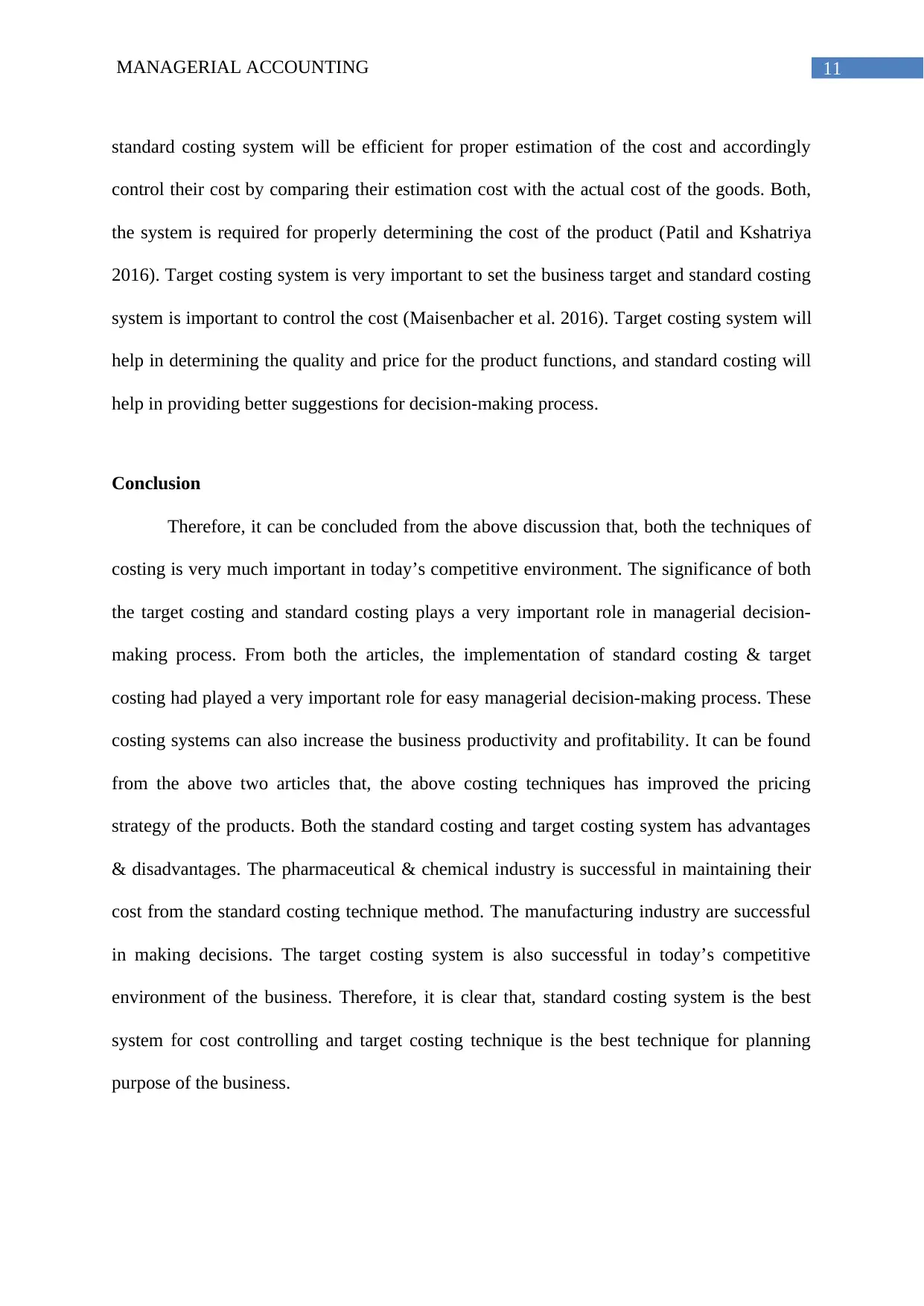
11MANAGERIAL ACCOUNTING
standard costing system will be efficient for proper estimation of the cost and accordingly
control their cost by comparing their estimation cost with the actual cost of the goods. Both,
the system is required for properly determining the cost of the product (Patil and Kshatriya
2016). Target costing system is very important to set the business target and standard costing
system is important to control the cost (Maisenbacher et al. 2016). Target costing system will
help in determining the quality and price for the product functions, and standard costing will
help in providing better suggestions for decision-making process.
Conclusion
Therefore, it can be concluded from the above discussion that, both the techniques of
costing is very much important in today’s competitive environment. The significance of both
the target costing and standard costing plays a very important role in managerial decision-
making process. From both the articles, the implementation of standard costing & target
costing had played a very important role for easy managerial decision-making process. These
costing systems can also increase the business productivity and profitability. It can be found
from the above two articles that, the above costing techniques has improved the pricing
strategy of the products. Both the standard costing and target costing system has advantages
& disadvantages. The pharmaceutical & chemical industry is successful in maintaining their
cost from the standard costing technique method. The manufacturing industry are successful
in making decisions. The target costing system is also successful in today’s competitive
environment of the business. Therefore, it is clear that, standard costing system is the best
system for cost controlling and target costing technique is the best technique for planning
purpose of the business.
standard costing system will be efficient for proper estimation of the cost and accordingly
control their cost by comparing their estimation cost with the actual cost of the goods. Both,
the system is required for properly determining the cost of the product (Patil and Kshatriya
2016). Target costing system is very important to set the business target and standard costing
system is important to control the cost (Maisenbacher et al. 2016). Target costing system will
help in determining the quality and price for the product functions, and standard costing will
help in providing better suggestions for decision-making process.
Conclusion
Therefore, it can be concluded from the above discussion that, both the techniques of
costing is very much important in today’s competitive environment. The significance of both
the target costing and standard costing plays a very important role in managerial decision-
making process. From both the articles, the implementation of standard costing & target
costing had played a very important role for easy managerial decision-making process. These
costing systems can also increase the business productivity and profitability. It can be found
from the above two articles that, the above costing techniques has improved the pricing
strategy of the products. Both the standard costing and target costing system has advantages
& disadvantages. The pharmaceutical & chemical industry is successful in maintaining their
cost from the standard costing technique method. The manufacturing industry are successful
in making decisions. The target costing system is also successful in today’s competitive
environment of the business. Therefore, it is clear that, standard costing system is the best
system for cost controlling and target costing technique is the best technique for planning
purpose of the business.
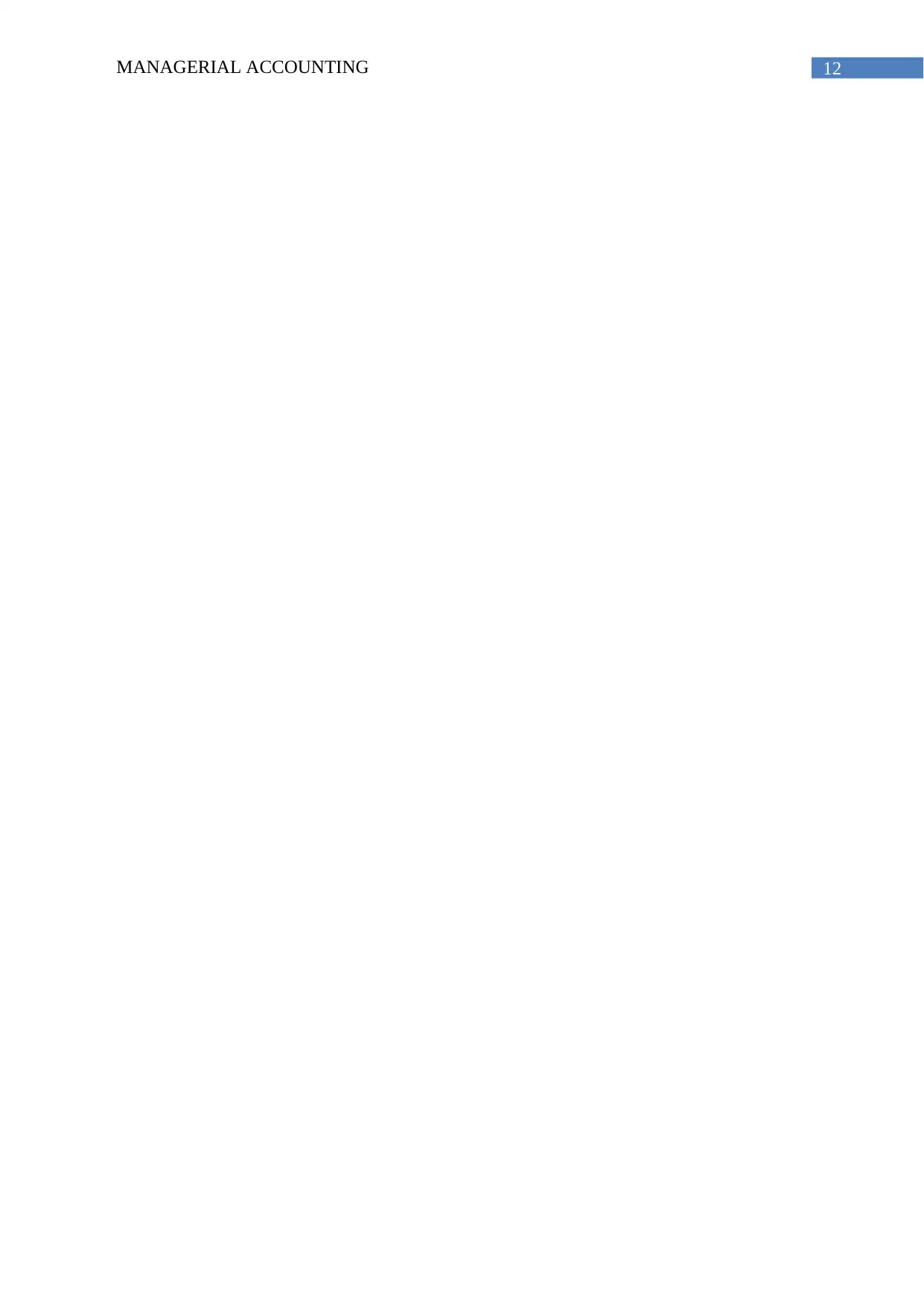
12MANAGERIAL ACCOUNTING
Paraphrase This Document
Need a fresh take? Get an instant paraphrase of this document with our AI Paraphraser
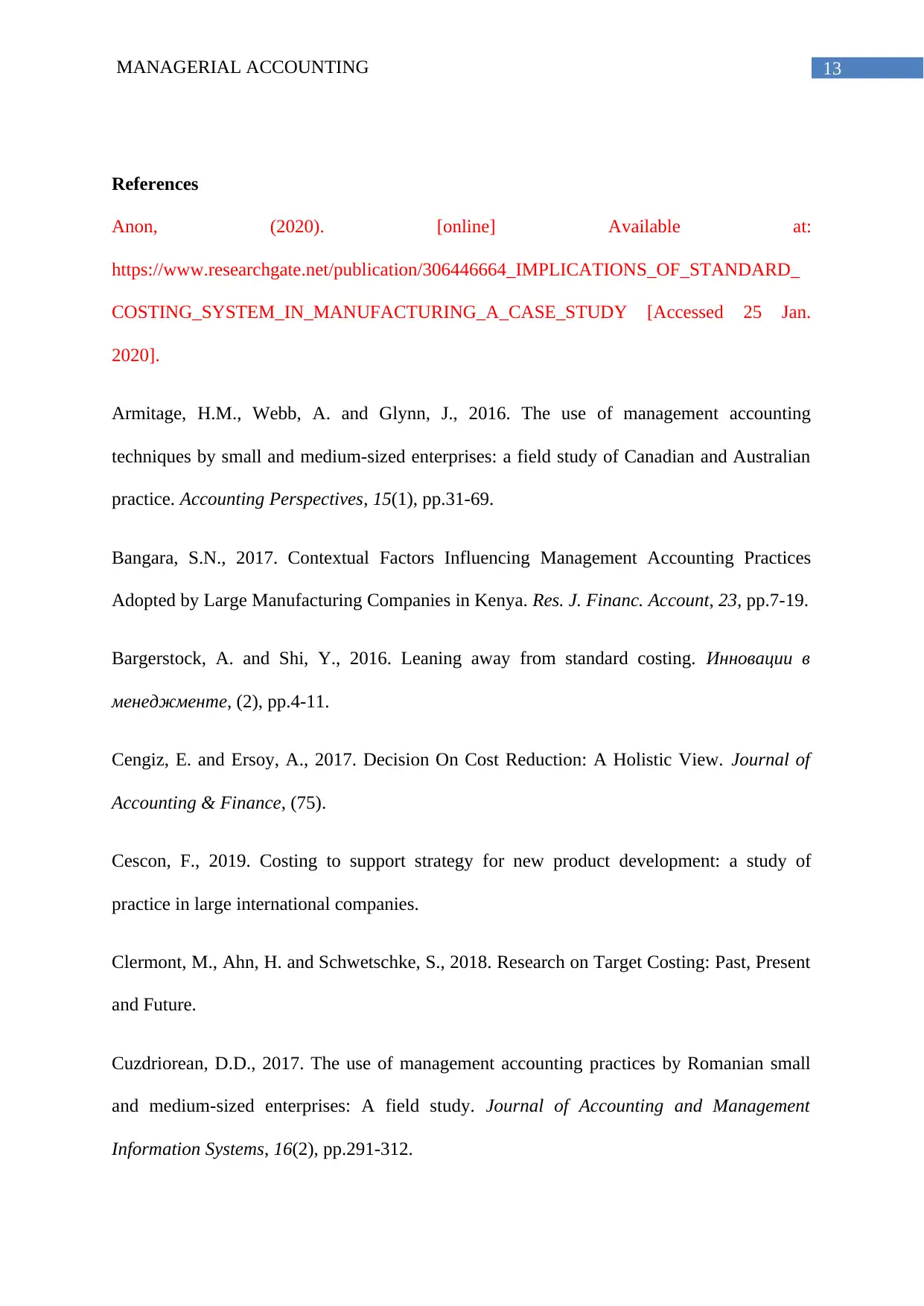
13MANAGERIAL ACCOUNTING
References
Anon, (2020). [online] Available at:
https://www.researchgate.net/publication/306446664_IMPLICATIONS_OF_STANDARD_
COSTING_SYSTEM_IN_MANUFACTURING_A_CASE_STUDY [Accessed 25 Jan.
2020].
Armitage, H.M., Webb, A. and Glynn, J., 2016. The use of management accounting
techniques by small and medium‐sized enterprises: a field study of Canadian and Australian
practice. Accounting Perspectives, 15(1), pp.31-69.
Bangara, S.N., 2017. Contextual Factors Influencing Management Accounting Practices
Adopted by Large Manufacturing Companies in Kenya. Res. J. Financ. Account, 23, pp.7-19.
Bargerstock, A. and Shi, Y., 2016. Leaning away from standard costing. Инновации в
менеджменте, (2), pp.4-11.
Cengiz, E. and Ersoy, A., 2017. Decision On Cost Reduction: A Holistic View. Journal of
Accounting & Finance, (75).
Cescon, F., 2019. Costing to support strategy for new product development: a study of
practice in large international companies.
Clermont, M., Ahn, H. and Schwetschke, S., 2018. Research on Target Costing: Past, Present
and Future.
Cuzdriorean, D.D., 2017. The use of management accounting practices by Romanian small
and medium-sized enterprises: A field study. Journal of Accounting and Management
Information Systems, 16(2), pp.291-312.
References
Anon, (2020). [online] Available at:
https://www.researchgate.net/publication/306446664_IMPLICATIONS_OF_STANDARD_
COSTING_SYSTEM_IN_MANUFACTURING_A_CASE_STUDY [Accessed 25 Jan.
2020].
Armitage, H.M., Webb, A. and Glynn, J., 2016. The use of management accounting
techniques by small and medium‐sized enterprises: a field study of Canadian and Australian
practice. Accounting Perspectives, 15(1), pp.31-69.
Bangara, S.N., 2017. Contextual Factors Influencing Management Accounting Practices
Adopted by Large Manufacturing Companies in Kenya. Res. J. Financ. Account, 23, pp.7-19.
Bargerstock, A. and Shi, Y., 2016. Leaning away from standard costing. Инновации в
менеджменте, (2), pp.4-11.
Cengiz, E. and Ersoy, A., 2017. Decision On Cost Reduction: A Holistic View. Journal of
Accounting & Finance, (75).
Cescon, F., 2019. Costing to support strategy for new product development: a study of
practice in large international companies.
Clermont, M., Ahn, H. and Schwetschke, S., 2018. Research on Target Costing: Past, Present
and Future.
Cuzdriorean, D.D., 2017. The use of management accounting practices by Romanian small
and medium-sized enterprises: A field study. Journal of Accounting and Management
Information Systems, 16(2), pp.291-312.
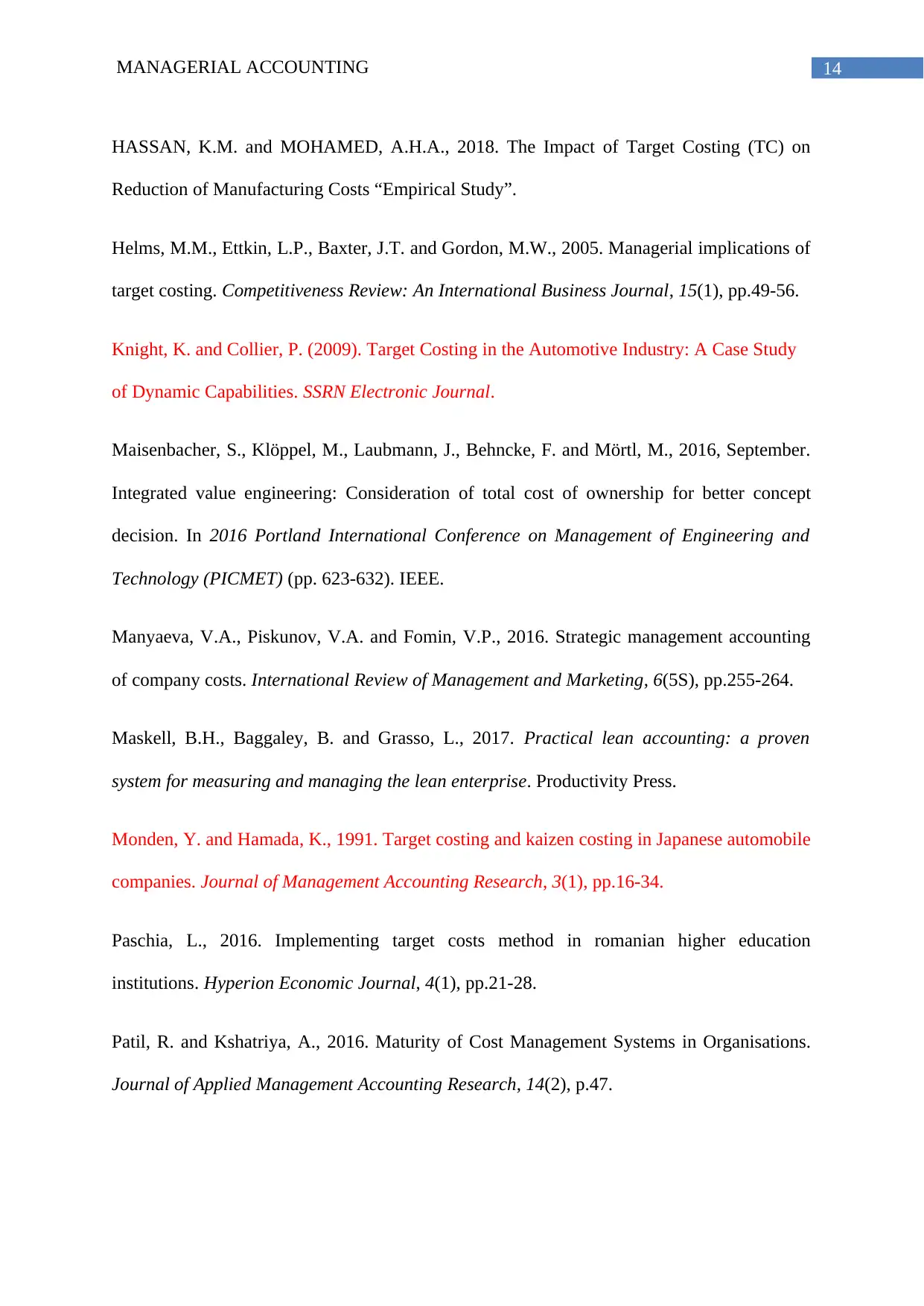
14MANAGERIAL ACCOUNTING
HASSAN, K.M. and MOHAMED, A.H.A., 2018. The Impact of Target Costing (TC) on
Reduction of Manufacturing Costs “Empirical Study”.
Helms, M.M., Ettkin, L.P., Baxter, J.T. and Gordon, M.W., 2005. Managerial implications of
target costing. Competitiveness Review: An International Business Journal, 15(1), pp.49-56.
Knight, K. and Collier, P. (2009). Target Costing in the Automotive Industry: A Case Study
of Dynamic Capabilities. SSRN Electronic Journal.
Maisenbacher, S., Klöppel, M., Laubmann, J., Behncke, F. and Mörtl, M., 2016, September.
Integrated value engineering: Consideration of total cost of ownership for better concept
decision. In 2016 Portland International Conference on Management of Engineering and
Technology (PICMET) (pp. 623-632). IEEE.
Manyaeva, V.A., Piskunov, V.A. and Fomin, V.P., 2016. Strategic management accounting
of company costs. International Review of Management and Marketing, 6(5S), pp.255-264.
Maskell, B.H., Baggaley, B. and Grasso, L., 2017. Practical lean accounting: a proven
system for measuring and managing the lean enterprise. Productivity Press.
Monden, Y. and Hamada, K., 1991. Target costing and kaizen costing in Japanese automobile
companies. Journal of Management Accounting Research, 3(1), pp.16-34.
Paschia, L., 2016. Implementing target costs method in romanian higher education
institutions. Hyperion Economic Journal, 4(1), pp.21-28.
Patil, R. and Kshatriya, A., 2016. Maturity of Cost Management Systems in Organisations.
Journal of Applied Management Accounting Research, 14(2), p.47.
HASSAN, K.M. and MOHAMED, A.H.A., 2018. The Impact of Target Costing (TC) on
Reduction of Manufacturing Costs “Empirical Study”.
Helms, M.M., Ettkin, L.P., Baxter, J.T. and Gordon, M.W., 2005. Managerial implications of
target costing. Competitiveness Review: An International Business Journal, 15(1), pp.49-56.
Knight, K. and Collier, P. (2009). Target Costing in the Automotive Industry: A Case Study
of Dynamic Capabilities. SSRN Electronic Journal.
Maisenbacher, S., Klöppel, M., Laubmann, J., Behncke, F. and Mörtl, M., 2016, September.
Integrated value engineering: Consideration of total cost of ownership for better concept
decision. In 2016 Portland International Conference on Management of Engineering and
Technology (PICMET) (pp. 623-632). IEEE.
Manyaeva, V.A., Piskunov, V.A. and Fomin, V.P., 2016. Strategic management accounting
of company costs. International Review of Management and Marketing, 6(5S), pp.255-264.
Maskell, B.H., Baggaley, B. and Grasso, L., 2017. Practical lean accounting: a proven
system for measuring and managing the lean enterprise. Productivity Press.
Monden, Y. and Hamada, K., 1991. Target costing and kaizen costing in Japanese automobile
companies. Journal of Management Accounting Research, 3(1), pp.16-34.
Paschia, L., 2016. Implementing target costs method in romanian higher education
institutions. Hyperion Economic Journal, 4(1), pp.21-28.
Patil, R. and Kshatriya, A., 2016. Maturity of Cost Management Systems in Organisations.
Journal of Applied Management Accounting Research, 14(2), p.47.
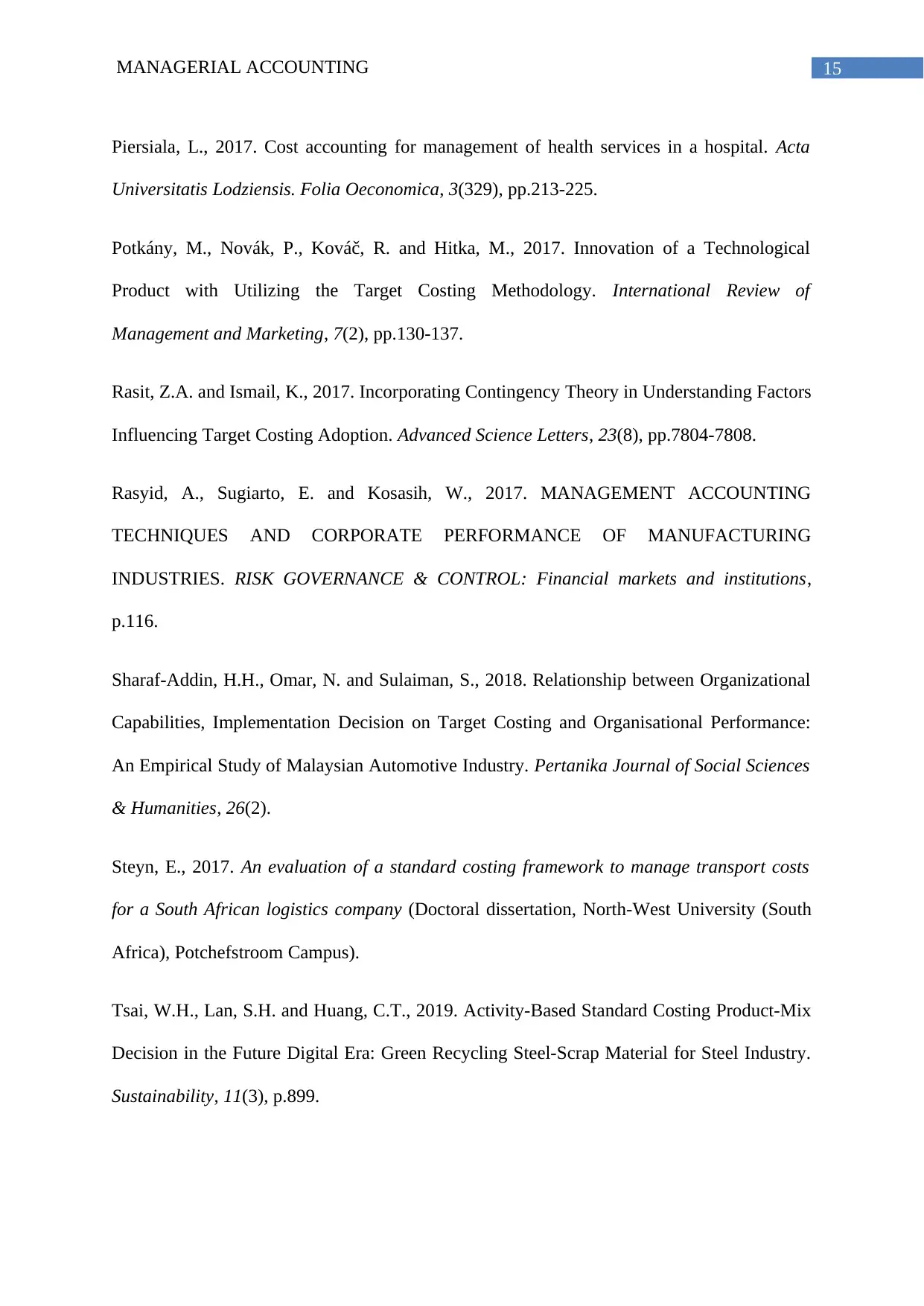
15MANAGERIAL ACCOUNTING
Piersiala, L., 2017. Cost accounting for management of health services in a hospital. Acta
Universitatis Lodziensis. Folia Oeconomica, 3(329), pp.213-225.
Potkány, M., Novák, P., Kováč, R. and Hitka, M., 2017. Innovation of a Technological
Product with Utilizing the Target Costing Methodology. International Review of
Management and Marketing, 7(2), pp.130-137.
Rasit, Z.A. and Ismail, K., 2017. Incorporating Contingency Theory in Understanding Factors
Influencing Target Costing Adoption. Advanced Science Letters, 23(8), pp.7804-7808.
Rasyid, A., Sugiarto, E. and Kosasih, W., 2017. MANAGEMENT ACCOUNTING
TECHNIQUES AND CORPORATE PERFORMANCE OF MANUFACTURING
INDUSTRIES. RISK GOVERNANCE & CONTROL: Financial markets and institutions,
p.116.
Sharaf-Addin, H.H., Omar, N. and Sulaiman, S., 2018. Relationship between Organizational
Capabilities, Implementation Decision on Target Costing and Organisational Performance:
An Empirical Study of Malaysian Automotive Industry. Pertanika Journal of Social Sciences
& Humanities, 26(2).
Steyn, E., 2017. An evaluation of a standard costing framework to manage transport costs
for a South African logistics company (Doctoral dissertation, North-West University (South
Africa), Potchefstroom Campus).
Tsai, W.H., Lan, S.H. and Huang, C.T., 2019. Activity-Based Standard Costing Product-Mix
Decision in the Future Digital Era: Green Recycling Steel-Scrap Material for Steel Industry.
Sustainability, 11(3), p.899.
Piersiala, L., 2017. Cost accounting for management of health services in a hospital. Acta
Universitatis Lodziensis. Folia Oeconomica, 3(329), pp.213-225.
Potkány, M., Novák, P., Kováč, R. and Hitka, M., 2017. Innovation of a Technological
Product with Utilizing the Target Costing Methodology. International Review of
Management and Marketing, 7(2), pp.130-137.
Rasit, Z.A. and Ismail, K., 2017. Incorporating Contingency Theory in Understanding Factors
Influencing Target Costing Adoption. Advanced Science Letters, 23(8), pp.7804-7808.
Rasyid, A., Sugiarto, E. and Kosasih, W., 2017. MANAGEMENT ACCOUNTING
TECHNIQUES AND CORPORATE PERFORMANCE OF MANUFACTURING
INDUSTRIES. RISK GOVERNANCE & CONTROL: Financial markets and institutions,
p.116.
Sharaf-Addin, H.H., Omar, N. and Sulaiman, S., 2018. Relationship between Organizational
Capabilities, Implementation Decision on Target Costing and Organisational Performance:
An Empirical Study of Malaysian Automotive Industry. Pertanika Journal of Social Sciences
& Humanities, 26(2).
Steyn, E., 2017. An evaluation of a standard costing framework to manage transport costs
for a South African logistics company (Doctoral dissertation, North-West University (South
Africa), Potchefstroom Campus).
Tsai, W.H., Lan, S.H. and Huang, C.T., 2019. Activity-Based Standard Costing Product-Mix
Decision in the Future Digital Era: Green Recycling Steel-Scrap Material for Steel Industry.
Sustainability, 11(3), p.899.
Secure Best Marks with AI Grader
Need help grading? Try our AI Grader for instant feedback on your assignments.
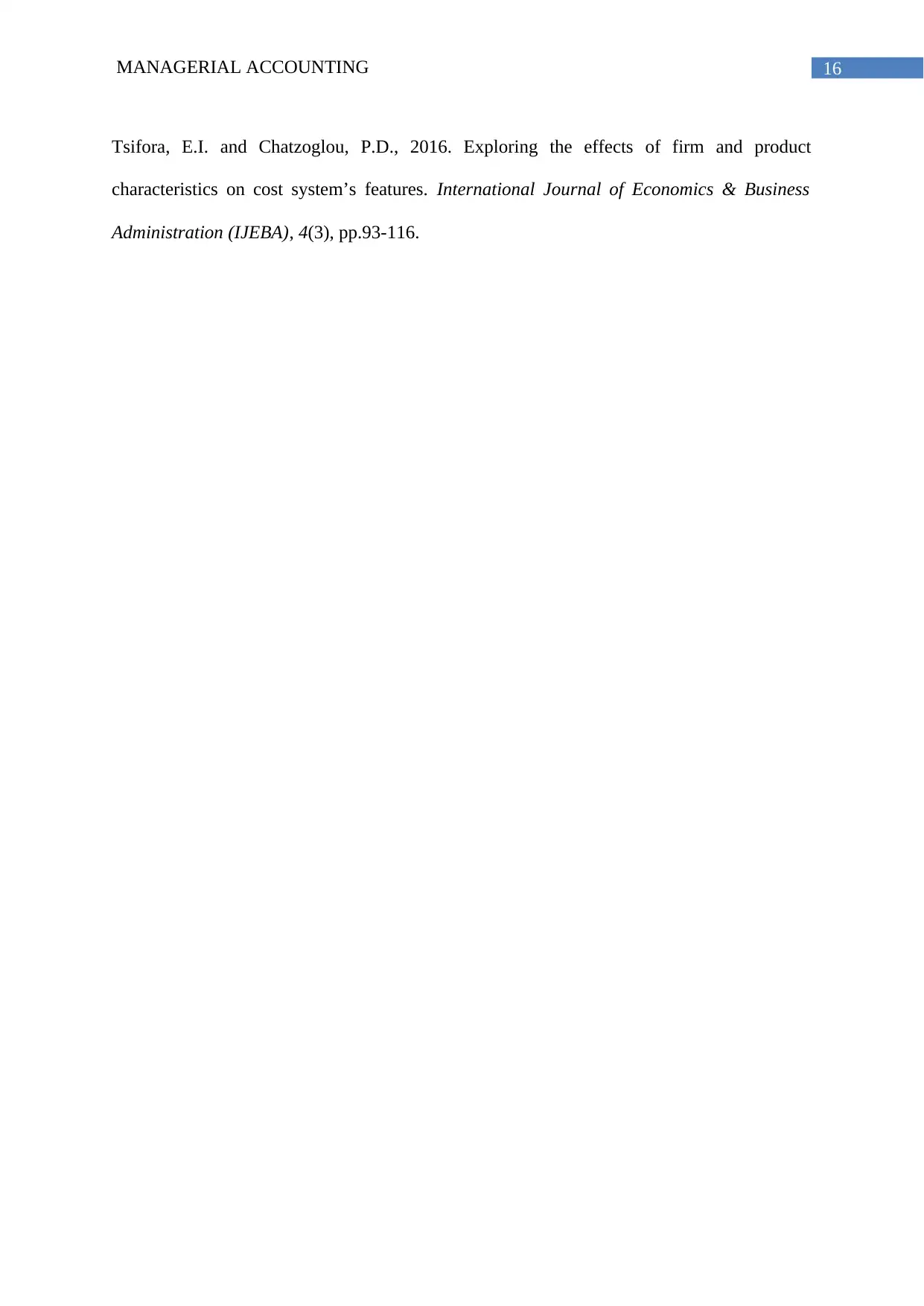
16MANAGERIAL ACCOUNTING
Tsifora, E.I. and Chatzoglou, P.D., 2016. Exploring the effects of firm and product
characteristics on cost system’s features. International Journal of Economics & Business
Administration (IJEBA), 4(3), pp.93-116.
Tsifora, E.I. and Chatzoglou, P.D., 2016. Exploring the effects of firm and product
characteristics on cost system’s features. International Journal of Economics & Business
Administration (IJEBA), 4(3), pp.93-116.
1 out of 17
Related Documents
Your All-in-One AI-Powered Toolkit for Academic Success.
+13062052269
info@desklib.com
Available 24*7 on WhatsApp / Email
![[object Object]](/_next/static/media/star-bottom.7253800d.svg)
Unlock your academic potential
© 2024 | Zucol Services PVT LTD | All rights reserved.





